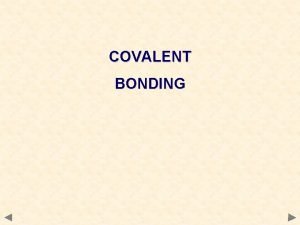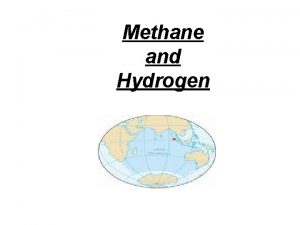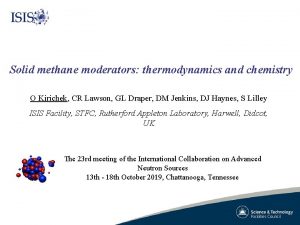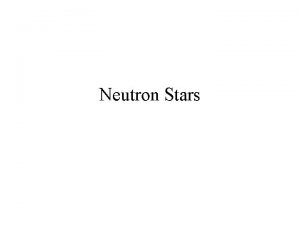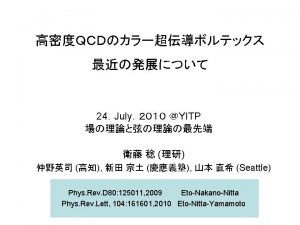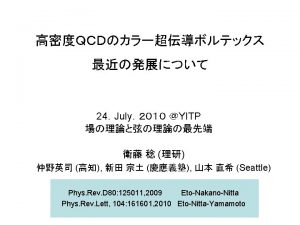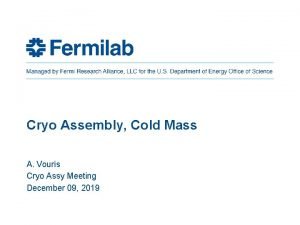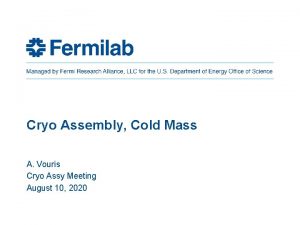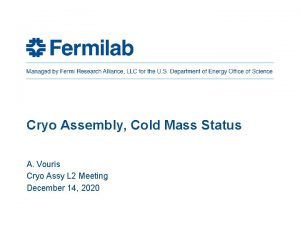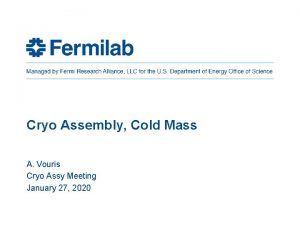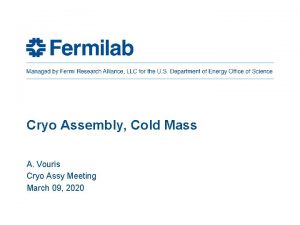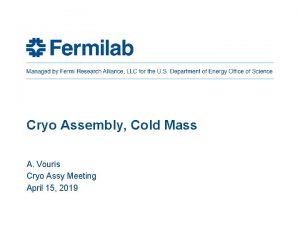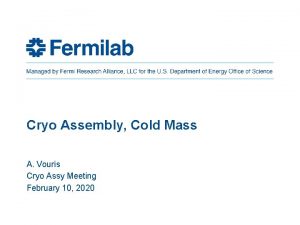Solid methane in radiation neutron cryo moderators and














- Slides: 14

Solid methane in radiation: neutron cryo moderators and cometary cryo volcanism O Kirichek, CR Lawson, DM Jenkins, CJT Ridley, DJ Haynes ISIS Facility, STFC, UKRI, Rutherford Appleton Laboratory, Harwell, Didcot, UK

ISIS Facility neutron spallation Target Station II (2009) Solid Methane Moderator (47 K) Target

Experimental set-up of the “solid methane poke test” 5 2 4 1 7 3 6 OK et al. Cryogenics 52 (2012), 325

Bond breaking force F/A, MPa 0. 3 0. 25 Breaking was not achieved 0. 2 0. 15 0. 1 Solid methane melting point is 90. 6 K 0. 05 0 0 20 40 T, K 60 Bonding produced at 70 K and breaking test conducted at the temperature of interest Bonding procedure as well as breaking test conducted at the same temperature 80 100

Solid methane viscosity temperature dependence Ya. Yamashita and M. Kato Results of penetration tests: viscosity of solid methane at 77 K µ = 3 108 Pa s µ , Pa s Arrhenius form with activation energy of 1300 K (T > 60 K) 1 E+10 E. Shabalin et. al. ~ 1100 K 1 E+09 1 E+08 Dynamic viscosity: Honey: 2 -10 Pa s Molten glass: up to 1000 Pa s Pahoehoe lava: 100 – 1000 Pa s 1 E+07 Andesite lava: 106 – 107 Pa s 1 E+06 1 E+05 0. 011 Rhyolite lava: 1011 – 1012 Pa s 0. 012 0. 013 T-1, K-1 0. 014 0. 015

Titan average surface temperature 94 K Methane melting point 90. 7 K This artist concept shows a lake and a mounting on the surface of Titan. Image credit: NASA/JPL In 2006 Cassini–Huygens mission detected on Titan Methane Ice and Snow on a top of more than 1. 5 km high mountings (NASA–ESA–ASI)

Pluto temperature range: from 33 K to 55 K In 2015 NASA’s New Horizons mission has observed Methane Snow on Pluto’s Peaks (3 – 4 km high)

Solid methane under exposure to neutron radiation “Burp” Phenomenon H + H → H 2 + 218 k. J/mol John Carpenter Nature 330, (1987) 358 CH 3 + CH 3 → C 2 H 6 + 368 k. J/mol Intense Pulsed Neutron Source (IPNS) Argonne National Laboratory, USA Analysis of volatile products from radiolysis of methane from the solid methane moderator Product Preferred IUPAC name Mole fraction (%) H 2 Hydrogen 5. 38 CH 4 Methane 91. 37 C 2 H 4 Ethylene 0. 20 C 2 H 6 Ethane 2. 3 C 3 H 8 Terminal Dimethyl 0. 42

Comparison of the model based on theory of thermal explosion with moderators test data H + H → H 2 + 218 k. J/mol J Carpenter Nature 330, (1987) 358 CH 3 + CH 3 → C 2 H 6 + 368 k. J/mol OK et al. Cryogenics 88, (2017) 101 (a) IPNS and (b) TS 2 solid methane moderator test data (dots) and time dependence of solid methane temperature obtained as an outcome of our model (line). Energy release during slow heating of the solid methane irradiated at 10 K. The blue line represents our model, red line is the Carpenter model

Temperature dependences of Thermostimulated exoelectron emission (TSEE) and Post-desorption from solid methane pre-irradiated by electrons Preliminary experimental results courtesy of Prof. E. V. Savchenko (ФТИНТ НАН Украины )

67 P/Churyumov–Gerasimenko Comet (1969) In 2014, the European Space Agency's Rosetta spacecraft reached the Comet 67 P and made remarkable observation: a number of the dust jets emerging from the Comet.

Cryo volcanoes Short-period comets orbit the sun over a period of less than < 200 years. Temperature of a comet in Kuiper Belt and the Oort Cloud 30 - 50 K

Conclusions • Methane adhesion to different kind of materials is very strong in 60 K – 90 K temperature range where solid methane behaves like a soft and sticky lollipop. • Below 50 K solid methane loses its stickiness and ductility and behaves more or less like an ordinary glass. • Exposure to radiation at low temperatures stores radiation defects in solid methane matrix. Warming up of the solid methane activates recombination of the radiation defects accompanied by substantial energy release which could lead to selfaccelerating heating. • The recombination process occurred in two stages: at low temperatures between 10 K and 20 K and at higher temperatures between 40 K and 60 K. • Understanding mechanisms of the “higher temperature” recombination is extremely important for solid methane moderators and comet tails formation.

We would like to thank: All the members of ISIS Cryogenics Team as well as other members of ISIS Sample Environment group, especially Andy Church, Dennis Cowdery, Richard Down, Rob Done and Jeff Keeping for active involvement and support. ISIS Top Management for sponsoring this project. We also appreciate the help we received from ISIS engineers and designers. We would also like to thank Prof E Savchenko’s group from Verkin Institute for Low Temperature Physics and Engineering, Kharkiv , Ukraine for sharing data with us and for fruitful discussions. Thank you very much for your attention!
 Cryo latin
Cryo latin Chole prefix
Chole prefix Crystalline vs amorphous
Crystalline vs amorphous Crystallography types
Crystallography types Crystalline solid
Crystalline solid Crystalline solid and amorphous solid
Crystalline solid and amorphous solid Anisotropic
Anisotropic Methane dot and cross diagram
Methane dot and cross diagram Methane and water
Methane and water Example of solid solution
Example of solid solution Covalent network solid vs molecular solid
Covalent network solid vs molecular solid When a solid completely penetrates another solid
When a solid completely penetrates another solid Interpenetration of surfaces
Interpenetration of surfaces Sifting mixture
Sifting mixture Isis neutron and muon source
Isis neutron and muon source







